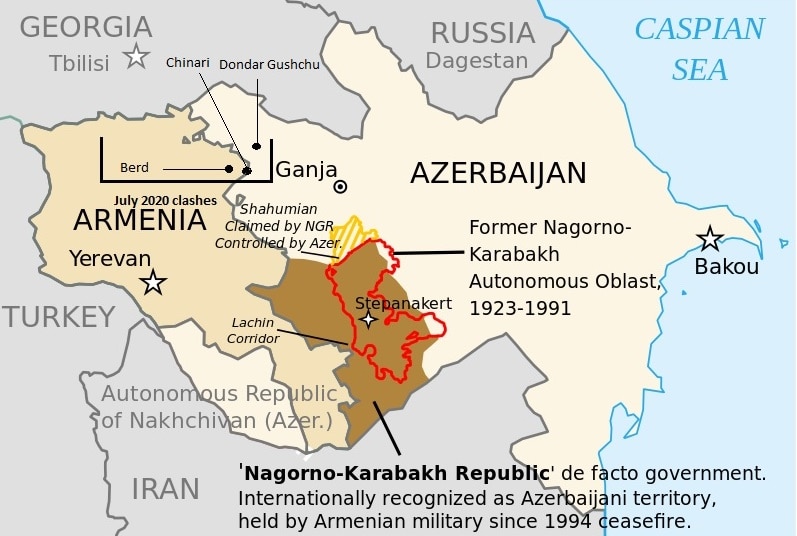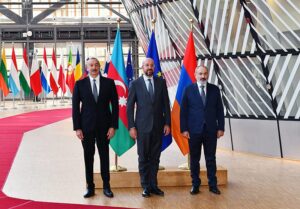The current fighting between Armenia and Azerbaijan is now the deadliest since the “April War” in 2016 when the two countries have been battling over the disputed Nagorno-Karabakh territory for four days. The “April War” took place on the Line of Contact (LoC) around the Nagorno-Karabakh, which makes the current flare-up on the international border between Armenia and Azerbaijan the most serious one since the 1990s.
On the 12th of July, the conflict escalated in Berd and Chinari (Armenia) and in Dondar Gushchu (Azerbaijan). A general and well known colonel in Azerbaijan were killed, 15 soldiers died on both sides, one Azerbaijani civilian died along a remote northern section of the border and Armenian civilian has been wounded from an Azeri drone attack. Azerbaijan government stated that it could easily target Armenia’s Soviet-era nuclear power plant with its state-of-the-art missile system which could have devastating consequences for Armenia.
However, it remains unclear which side violated cease-fire first. There are no independent sources of information and borders between Armenia and Azerbaijan are mostly unmonitored. When the cease-fire is violated, Azerbaijan is usually to be blamed for, since Armenia already has military control over the disputed territory. Still taking into account that the conflict started on the border with Armenia, that logic is less applicable: Azerbaijan has less to gain by fighting in Armenia proper. Especially since any offensive operation on the border would trigger legal ground for the Collective Security Treaty Organization (CSTO), the Russia-led military alliance, to intervene. Even though CSTO has not offered any tangible help to Armenia, escalation of the conflict would put additional pressure on Russia to act in accordance to its legal obligations – otherwise, the vital instrument of Russian foreign and security policy in Eurasia, would seem irrelevant.
Thomas de Waal, a senior fellow at Carnegie Europe, acknowledged the familiar finger-pointing and lack of clarity but argued that interruptions in the nearly three-decade-old cease-fire between Armenia and Azerbaijan are “a political decision”. He also suggested that Baku might have been more frustrated at the current impasse – despite international mediators’ encouragement early last year that the leaders of Armenia and Azerbaijan should “prepare their populations for peace”.
Domestic reactions
In reaction to the clashes, thousands protested in Azerbaijan, calling for the mobilisation of the army to take over the disputed territory of Nagorno-Karabakh. A small group entered Parliament and allegedly smashed windows and chandeliers before security forces drove them out and police used a water cannon and tear gas to disperse the crowd in front of the building. This is the largest public gathering in Azerbaijan in recent years, and media reports mention the number of about 30,000 people.
Armenian Youth Federation (AYF) led a protest to stand in solidarity with Armenia in Los Angeles and Washington DC. They stated that the Armenian Army is the only guarantor of security in the region. Also on the 20th of July, the same organization from Greece organized a protest in front of the Azerbaijani Embassy in Athens. The protesters sang and performed military and patriotic songs and dances.
Historical background
Looking from historical perspective, the conflict between Azerbaijan and Armenia began in February 1988, when the Nagorno-Karabakh Region, with a majority Armenian population, announced its decision to leave the then Azerbaijani SR. In September 1991, the formation of the Nagorno-Karabakh Republic was announced in the so called „capital“, Stepanakert. Azerbaijani authorities lost control of Nagorno-Karabakh during the subsequent military conflict. Negotiations on a peaceful solution to the conflict within the Organization for Security and Cooperation in Europe’s (OSCE) Minsk Group have been underway since 1992. In 1994 both sides agreed on a cease-fire to end the widespread bloodshed, that killed around 30.000 people. However the cease-fire failed to resolve the dispute. Azerbaijan insists on preserving its territorial integrity, and Armenia is defending the interests of the unrecognised republic since Nagorno-Karabakh is not a party in the negotiations.
Future consequences
Peace talks mediated by the (OSCE) Minsk Group, co-chaired by the United States, Russia and France have proven fruitless so far. Without successful mediation efforts, cease-fire violations and renewed clashes could culminate in a military conflict between the countries and further destabilisation of the South Caucasus region. There is also broader Western interest involved since Azerbaijan is a significant oil and gas exporter to Europe and Central Asia. Additionally, current conflict can become a new flashpoint in a growing rivalry between Russia and Turkey. Russia has promised to defend Armenia and offered to act as a mediator, and Turkey has pledged to support Azerbaijan, with whom it shares linguistic and ethnic ties.
Sources: Politico, BBC, Aljazeera, Reuters, PRA
Photo: Wikimedia



